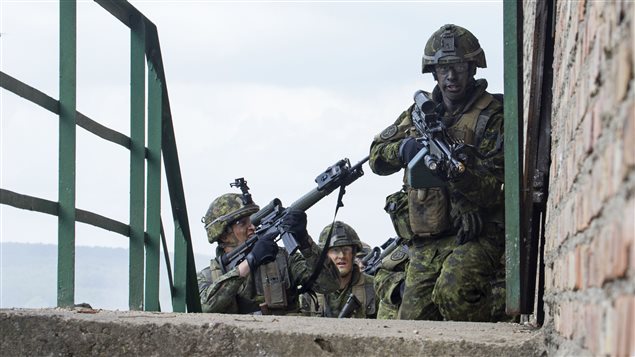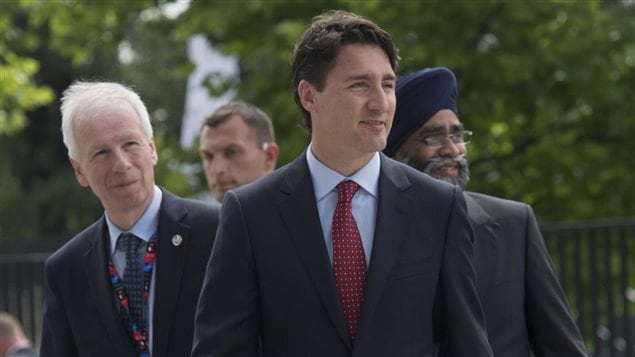Canada is deploying “its largest military contingent to Europe in more than a decade,” as NATO tries to reassure nervous Eastern European countries spooked by the increasingly assertive Russia.
Canada will lead a 1000-strong multinational NATO battlegroup in Latvia, becoming one of four Framework Nations, as part of the Alliance’s enhanced Forward Presence in Eastern Europe, Prime Minister Justin Trudeau announced Friday at a NATO summit in Poland.
“Canada is a playing a strong and constructive role in the world,” Trudeau said in a statement in Warsaw. “We are ready to respond to support NATO with some of the most effective soldiers, sailors, and airmen and airwomen in the world. We will continue to work closely with our Allies and partners to create a safer and more prosperous world for everyone.”
Canada will send hundreds of troops to Latvia – the exact number is not clear yet – as well as fighter jets and a navy frigate to Eastern Europe, where tensions between NATO and Russia have reached levels not seen since the Cold War, following Russia’s annexation of Crimea and its support for pro-Russian rebels in Eastern Ukraine.
Germany, the United Kingdom and the United States have committed similar forces to Lithuania, Estonia and Poland, respectively.

Stephen Saideman, the Paterson Chair in International Affairs at Carleton University and author of Adapting in the Dust: Learning Lessons from Canada’s War in Afghanistan, said the 4,000-strong NATO deployment is designed to act as a sort of tripwire to change Russian calculations.
‘Cold War saber-rattling’
“The idea is to have forces present in the Baltics and in Poland to deter Russia from engaging in any more adventures,” Saideman said in earlier interview.
NATO’s decision to build-up its forces in proximity to Russia does not in any way contribute to strengthening the security situation in Europe, said Kirill Kalinin, spokesperson of the Russian Embassy in Canada.
“Russia is in no way presenting a threat to anyone,” Kalinin said. “However, we see this is a challenge and we will find necessary means to respond to it.”
NATO’s actions are reminiscent of Cold War saber-rattling and are a complete waste of money and resources, Kalinin said.
“Moreover, ‘the enemy at the gate’ is the real existential threat of international terrorism and at these pressing times common sense and pragmatism dictate the need to join efforts, as opposed to reincarnation of Cold War containment,” he said.
Latvia’s ministry of foreign affairs, on the other hand, welcomed Canada’s decision and announced that Foreign Affairs Minister Stephane Dion will visit Riga on July 11 to discuss “recent developments in bilateral and transatlantic cooperation, the results of the NATO Summit in Warsaw, and further steps in the implementation of NATO policy of deterrence and defence and the enhancement of the Allied presence in the Baltic States.”
During his visit, Dion will meet with Latvia’s Foreign Minister Edgars Rinkēvičs and the Minister of Defence Raimonds Bergmanis.
Canada’s top soldier Chief of Defence Staff Gen. Jonathan Vance said Canada is expected to deploy about 450 soldiers along with armoured vehicles. The rest of the 1,000-strong NATO force under the Canadian command is expected to come from other allies, including Norway and Denmark.
Up to six CF-18s will also be sent to Europe to help NATO patrol allied airspace against Russian threats. Canada deployed fighter jets in a similar role in 2014, but that mission ended in April 2015. The decision to send fighters comes despite the government warning that the Air Force is facing a shortage of CF-18s.
Canada has also had a frigate operating with a NATO force in the Mediterranean and Black seas since April 2014, where it has acted as a visible reminder to Russia of the alliance’s power at sea. HMCS Charlottetown recently replaced HMCS Fredericton in that role.
With files from The Canadian Press







For reasons beyond our control, and for an undetermined period of time, our comment section is now closed. However, our social networks remain open to your contributions.